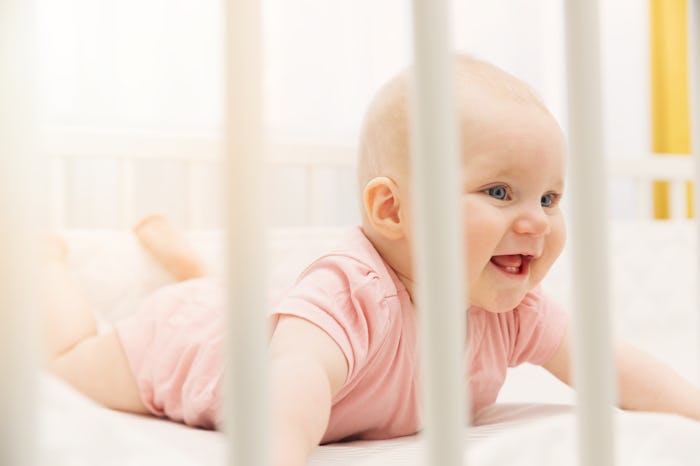Life

A List Of Everything You Can't Have In A Crib
Decorating your baby's nursery is one of those "wow this real" moments on the road to parenthood. Regardless of how you become a mom, choosing the colors, bedding, toys, and other decorations for your baby's living space is a parenting rite of passage. It's also confusing. With so many safety recommendations, and "thoughtful" advice from friends and family, it's hard to know what's best for the new addition to your family. So, what can't you have in a crib? Turns out, the list is rather long, so it's best to take heed now before you end up spending money on things your baby can't use for an extended period of time (no matter how devastatingly cute they are).
The American Academy of Pediatrics (AAP) advises parents to skip almost all adornments and decorations. Yes, that hurts my mom-heart probably just as much as yours, but the AAP tells parents to "avoid use of soft bedding, including crib bumpers, blankets, pillows, and soft boys. The crib should be bare."
These recommendations have been put in place to decrease the risk of Sudden Infant Death Syndrome (SIDS) which is included in the Sudden Unexpected Infant Death (SUID) statistics that are, honestly, staggering. According to The Center for Disease Control and Prevention (CDC), "in 2015, there were about 3,700 sudden unexpected infant deaths in the United States."
The importance of following safe sleep recommendations can not be overstated. The AAP noted a 50 percent decrease in SIDS related deaths after launching the "back to sleep" campaign, which encouraged parents to put their babies down to sleep on their back. In other words, following research-backed sleep recommendations can provide life-saving results.
The U.S. Consumer Product Safety Commission (CPSC) seems to agree, and advises parents that creating a safe sleeping space for babies means keeping it bare. The CPSC goes on to say, "A safe crib is one that is clear of clutter. That means no pillows, no heavy quilts, no thick blankets, no pillow-like stuffed toys or other large stuffed toys, and no child-carrying devices, recliners, or sleep positioners."
While makers of sleep positioners clam they keep infants in a specific position as they sleep, ensuring they won't move to a more, potentially dangerous position during the night, in 2012 The New York Times reported that after 13 deaths in 15 years, health officials warned "parents not to use a special device designed to help keep babies in certain positions as they sleep."
If you are concerned that your baby may be cold without blankets or covers, you could dress them in footed pajamas or put them in a close fitting sleep sack. It's worth noting that if your bedroom is at a comfortable temperature for you, then it is usually the right temperature for your baby, too. According to The National Institute of Child Health and Human Development, overheating can be a risk factor for SIDS, so parents should be careful not to overdress their little ones.
The things you should not be putting in your baby's crib include blankets, covers, pillows, toys, and anything your baby could pull into their crib or that could become a potential risk of suffocation or strangulation.
So while the countless crib decorations are as adorable as they are tempting, the best thing to remember is that a bare crib is a safe crib.